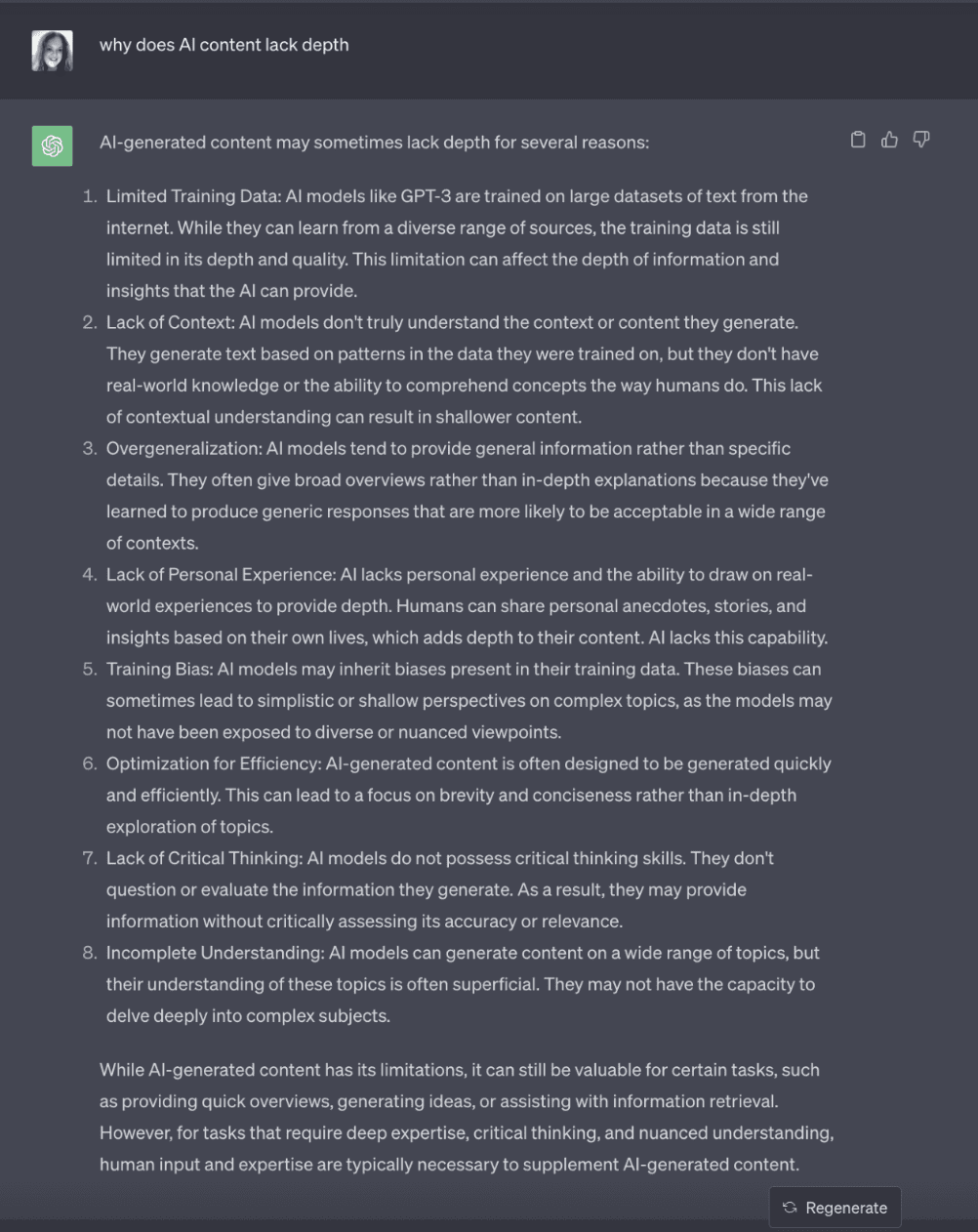We’re living in the age of generative AI. It’s a time where some people won’t know what it is, others will be suspicious of it, and sections of the population will be merrily trotting out AI content at pace in a bid to build up websites at scale.
This is all well and good, especially while Google grapples with the onslaught of AI content and decides whether it should be penalised or not. However, there are some ways to spot AI content – and as I couldn’t find any comprehensive thoughts on this topic, I decided to summarise my own insights.
Here’s a meta twist: I created parts of the content below using AI, in order to describe how AI can be spotted. Is your head spinning a bit? Good. Let’s begin…
1. Repetitive language
One of the easiest ways I have personally spotted AI content is by analysing the amount of repetition within a body of text. This is particularly prevalent when AI is listing benefits or highlighting key features. Here’s an example:
Sunscreen, also known as sun cream or sunblock, offers several benefits when applied correctly and consistently:
- Protection from UV radiation: Sunscreen provides a barrier that absorbs or reflects the harmful ultraviolet (UV) radiation from the sun. UV radiation can damage the skin and increase the risk of skin cancer.
- Sunburn prevention: Sunscreen helps prevent sunburn by blocking or absorbing UVB rays, which are responsible for causing sunburn and reddening of the skin.
- Reduced risk of hyperpigmentation: Sunscreen can help prevent the development of hyperpigmentation, such as dark spots and melasma, which can be triggered or worsened by sun exposure.
- Maintenance of an even skin tone: Sunscreen helps maintain a more even skin tone by protecting against the development of blotchiness, redness, and uneven pigmentation.
- Protection against eye damage: Sunscreen that is specifically designed for the eye area can protect the delicate skin around the eyes and reduce the risk of eye damage, including cataracts and macular degeneration.
- Skin barrier support: Sunscreen can help maintain the skin’s natural barrier function, reducing moisture loss and promoting healthier skin.
How many of those sentences began with the word ‘sunscreen’?
2. Over-use of enumeration
ChatGPT in particular likes to summarise information by providing lists of key factors, benefits or considerations within its sentences. When it responds to a prompt requesting information on a topic, it will display the response in as concise a manner as possible.
For example, a sentence about budget grocery shopping may read: ‘When you create a grocery list, ensure you include staples such as bread, milk and fruit. Consider adding food cupboard essentials such as pasta and bread for flexibility, convenience and value.’ Here, the enumeration is seen in ‘bread, milk and fruit’ as well as ‘flexibility, convenience and value’.
3. Formulaic paragraphs
Many of us studied PEE in school – which is short for Point, Evidence, Explain. This style of paragraph structure is used in academic or persuasive writing to help writers present their point, provide evidence to support it and then explain how the evidence supports their point.
Sometimes, in lieu of the Evidence section, AI paragraphs will provide examples of the point in action before explaining its benefits or significance. We could call this Point, Example, Explain.
Example of Point, Evidence, Explain:
Point: Recycling reduces the amount of waste sent to landfills.
Evidence: According to the Environmental Protection Agency (EPA), recycling one ton of paper can save 17 trees, 7,000 gallons of water, and 463 gallons of oil.
Explain: This evidence highlights the environmental benefits of recycling. By recycling paper, we can save valuable natural resources and reduce the strain on landfills. This not only conserves our planet’s resources but also helps mitigate the environmental impact of waste disposal.
Example of Point, Example, Explain:
Point: Regular exercise improves overall health.
Example: Consider two individuals, John and Lisa. John exercises for 30 minutes every day, which includes jogging and bodyweight exercises. Lisa, however, leads a sedentary lifestyle and rarely engages in physical activity.
Explain: John’s regular exercise routine has led to improved cardiovascular health, increased energy levels, and better mood. In contrast, Lisa’s lack of physical activity has resulted in lower energy, weight gain, and increased risk of health issues like heart disease. This example highlights the significant benefits of incorporating regular exercise into one’s life, including better physical and mental health.
I created the examples using ChatGPT. Have you spotted the enumeration?
4. Lack of depth
As I described in my piece on AI-proof content tricks, generative AI will never be able to draw on real experience to create comprehensive, original content. I was going to summarise the ways in which AI is lacking, but I decided to make ChatGPT critique itself instead:

5. Neat introductions and conclusions
If there’s one thing generative AI loves, it’s a solid structure. As part of its machine learning, it was most likely fed the ‘ideal formula’ for a blog, article or short story. In general, these all begin with a beginning and end with an ending.
As a result, you’ll see that many of the more in-depth responses will feature a tidy introduction and a neat little conclusion, summarising key points. For example, you’ll see the introduction to the sunscreen output if you scroll back up to my first point. The output concluded with the below:
It’s important to choose a broad-spectrum sunscreen with an appropriate SPF (Sun Protection Factor) for your skin type and the level of sun exposure you anticipate. Additionally, it’s crucial to apply sunscreen generously and reapply it regularly, especially after swimming or sweating, to ensure maximum protection. Remember that sunscreen is just one part of sun protection; wearing protective clothing, sunglasses, and seeking shade when necessary are also essential for comprehensive sun safety.
This paragraph ticks all of the AI boxes – doesn’t go into too much detail, doesn’t draw on real, human experience, uses enumeration to drive the point home, summarises the main points to ‘round off’ the output.
6. Generic tone of voice
If you’ve spent any decent length of time creating content, you’ll have noticed that AI content sounds…exactly the same, no matter what prompt you put in. There isn’t a way to infuse ChatGPT, Google Bard or Bing AI with a unique, original personality and then teach it how to create entertaining content.
As a result, you’re left with content that covers the basics in a polite, formal tone. You get neat, formulaic summaries of key points, expertly structured and blandly laid out. It ticks the basic boxes – but it isn’t memorable.
On the other end of the spectrum, there are engaging, entertaining and distinctive narrative voices which can be found online and linked to real humans. For example, Joel Golby’s witty ‘Rental Opportunity of the Week’ series on Vice or Imogen Groome’s wonderful ‘I don’t want you in my life if…’ series on Metro (yes, I’m talking about myself.)
Need help with your content?
If your content is looking a bit too formulaic, find out how our experienced SEO content creators can generate fabulous content that satisfies EEAT criteria and boosts your organic performance.
Get in touch with us today to start the conversation, or book in for a Free Acquisitions Workshop, where you will receive one-to-one expert advice from our experienced marketers, resources, and a tailored action plan to make sure your content remains a cut above the rest.












